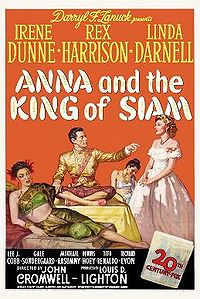
ANNA AND THE KING OF SIAM
US, 1946, 128 minutes, Black and white.
Irene Dunne, Rex Harrison, Linda Darnell, Lee J. Cobb, Gale Sondergaard.
Directed by John Cromwell.
Anna and the King of Siam was the first version of the very well known story of the English governess who travelled to Siam to be the educator of the king’s many children. In this version she is called Anna Owens. The film is an opportunity for a strong performance by Irene Dunne, popular in many films since the 1930s (Showboat, The Awful Truth, Penny Serenade). It also brought British actor, Rex Harrison, to the American screen. He had had a successful career in Britain (Major Barbara) but appeared in a number of films in Hollywood including The Foxes of Harrow with Maureen O’Hara?. Linda Darnell had emerged at 20th Century Fox as a star and appears as Tuptim, Lee J. Cobb was also beginning his career. Gale Sondegaard was nominated for an Oscar for best supporting actress for her performance as Lady Thiang. In fact, the film won Oscars for best set decoration and best black and white cinematography.
The film offers a portrait of an assured British woman who came to Siam with her young son in order to be an educator. She has to open her eyes to a different culture. The King of Siam also wanted to open Siam to a broader world culture but was trapped in many of his traditions.
Audiences are more familiar with this story from Rodgers’ and Hammerstein’s musical, filmed in 1956 with Yul Brynner and Deborah Kerr – with many popular songs, still very well known.
In 1999 there was a further version, Anna and the King, with Jodie Foster playing Anna and Hong Kong actor, Chow Yung Fat as the king.
1. How is this film an example of 1940s film-making? How did it compare to the musical version, ‘The King and I’? Was the film a spectacle? The elaborateness of set and design? How serious a portrayal of Siam and the nineteenth century? How enjoyable?
2. How well did the film blend its themes of colonialism in the 19th century - 19th. century attitudes and beliefs? Victorian behaviours ? The role of science and progress in the world? The relationship of Europe and Asia?
3. What did the film have to say on the clash of cultures? The Siamese accused of barbarism? The nature of barbarism and culture in Siam? The nature of culture in the English? What is culture and what is barbarism?
4. How attractive a character was Anna? In her modern views, as a woman in the court of Siam, the place of women in Siam? 19th century British attitudes? A move to democracy and equality? in bowing etc.? Comment on Anna’s determination of character, her strong will, her sympathy, wisdom, her success in Siam and her failures? Why did she fail the King and the Prince? What spurred her to success? How admirable a character was she meant to be?
5. How interesting a character was the king.? As a person, monarch, his presumptions about absolutism? His boyishness, his pride Was he barbaric? Civilization and culture, his aims of science and progress for Siam, his politics? His barbarism in the execution of Tuc Tim? What had he achieved by his death?
6. The portrayal of the Siamese people: the advisor and his wisdom in support of the king, Lady Tiang as illustrating the life of the harem, women in Siam, the subjugation of emotions, her wisdom, friendship with Anna, belief in her son, the Prince? Women in Siam, the courtiers?
7. The impact of the Tuc Tim episode? The arrogance and petulance of Tuc Tim, her role in the palace with the king and Anna? Her spite with the slave woman? Her escape and her torture? The impact of this and the cruelty of her death? Facing the Buddhist monk? What tone did this give to the film?
8. How attractive and enjoyable were such sequences as the lessons, the pursuit of the king about the house, the banquet and its preparations in cutlery and dress, the death of the king?
9. What did the film have to say about men and women and their relationships, in an old world and in a new world?
10. What did the film have to say about the values of human warmth, understanding, friendship? How attractive was the film with these themes?